More Bridges Than Venice - And A Lot More steel
If you’ve ever driven into Pittsburgh for the first time, you probably remember it vividly — maybe it was through the Fort Pitt Tunnel with that jaw-dropping view of the city skyline, flanked by bridges in every direction. That moment never gets old. As someone who has called Pittsburgh home for her entire life, I’ve come to appreciate just how vital these bridges are — not just as infrastructure, but as part of the city’s identity.
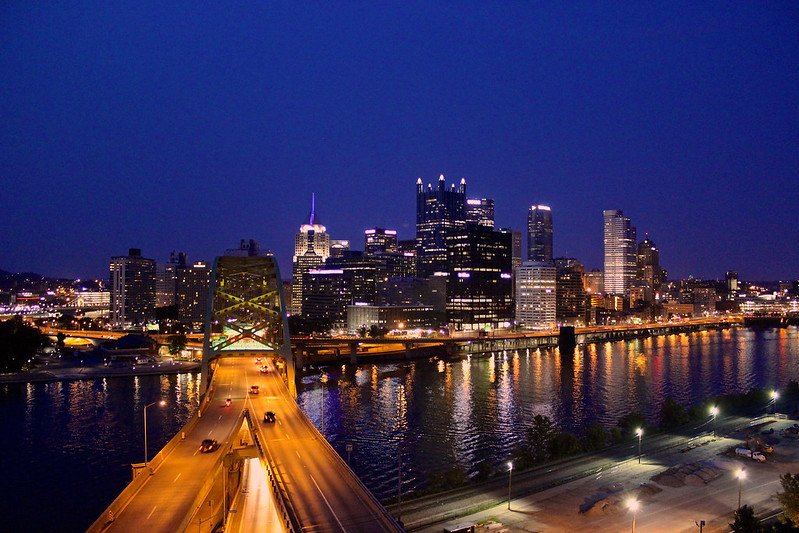
Pittsburgh is famously known as “The City of Bridges,” and for good reason. With 446 bridges, we actually have more than Venice, Italy! That number isn’t just a fun fact — it reflects the city’s unique geography, nestled between three rivers and surrounded by steep hills. Let’s take a look at some of the most famous bridges in Pittsburgh, the rivers they cross, and the history they carry.

The Three Rivers That Shape Pittsburgh
Before we dive into specific bridges, it’s important to understand Pittsburgh’s geography. The city sits at the confluence of the Allegheny and Monongahela Rivers, which meet at Point State Park to form the Ohio River. This “Golden Triangle” is where many of the city’s most well-known bridges are located.
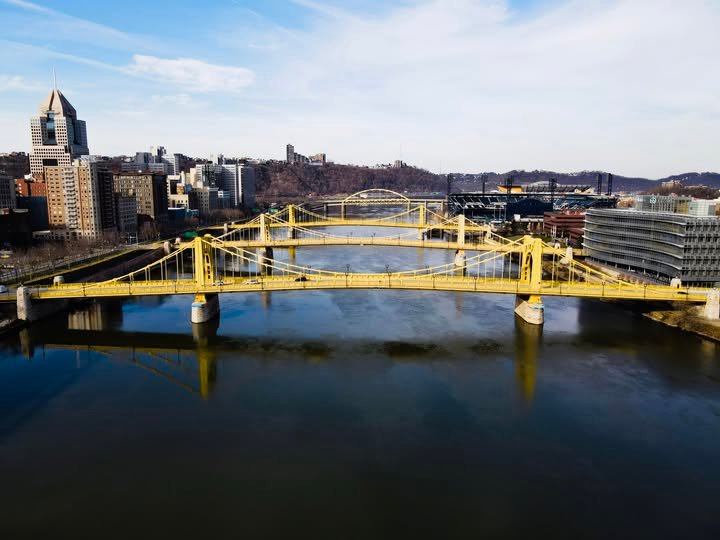
The Three Sisters:
Roberto Clemente, Andy Warhol, and Rachel Carson Bridges
Spanning the Allegheny River, the Three Sisters Bridges—built between 1926 and 1928—are a rare trio of nearly identical, self-anchored suspension bridges standing side by side. Painted in the city’s signature shade of yellow, these iconic structures connect Downtown Pittsburgh to the North Shore and are named after three of Pittsburgh’s most celebrated figures: Roberto Clemente, the legendary Pirates outfielder; Andy Warhol, the groundbreaking pop artist; and Rachel Carson, the pioneering environmentalist and author of Silent Spring.
More than just engineering marvels, these bridges reflect the heart of Pittsburgh’s culture—where sports, creativity, and environmental awareness intersect. And if you’re heading to a Pirates game at PNC Park, there’s a good chance you’ll be walking across the Roberto Clemente Bridge to get there!
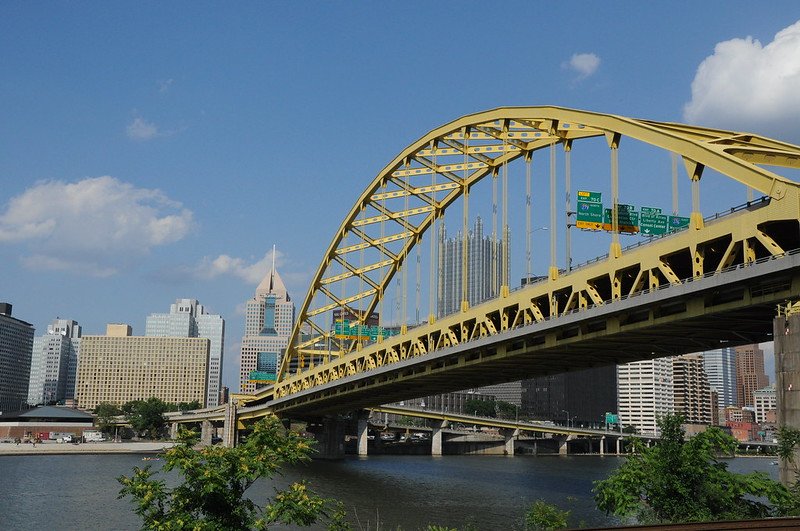
Fort Pitt Bridge
Crossing the Monongahela River right at its confluence with the Allegheny to form the Ohio River, the Fort Pitt Bridge opened in 1959 and offers one of the most dramatic entrances to any city in the country. As you emerge from the Fort Pitt Tunnel, the full Pittsburgh skyline suddenly bursts into view. This double-decked steel arch bridge replaced the old Point Bridge and has since become one of the city’s most iconic and heavily used connections into Downtown from the west.
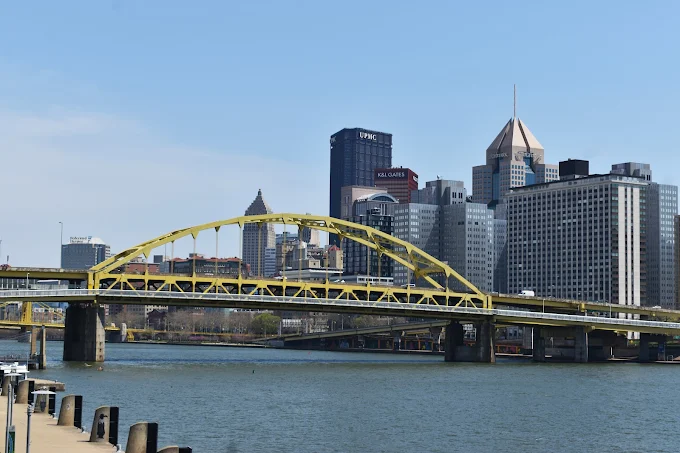
Fort Duquesne Bridge
Stretching over the Allegheny River, the Fort Duquesne Bridge opened in 1969 as a major connection from the North Shore into Downtown Pittsburgh. But for many years, it was dubbed the “Bridge to Nowhere” because its northern ramps weren’t completed until 1986, nearly 17 years later, due to legal and land acquisition delays. Today, the bridge carries thousands of commuters daily and connects visitors to key attractions like PNC Park, the Andy Warhol Museum, and the North Shore Trail.
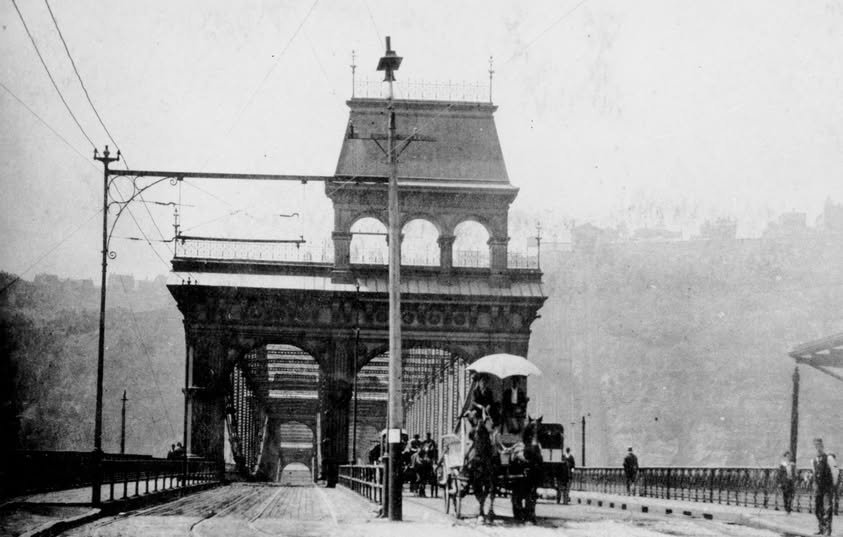
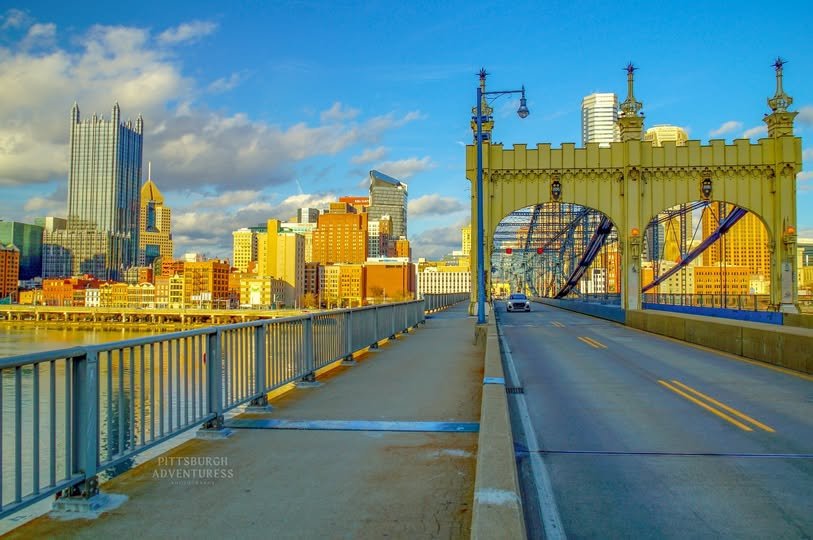
Smithfield Street Bridge
One of the most historic bridges in the city, the Smithfield Street Bridge spans the Monongahela River and was built in 1883, replacing earlier wooden and iron structures that had occupied the same spot. Designed by renowned engineer Gustav Lindenthal, this bridge is recognized as the oldest steel bridge still in use in the United States and is designated a National Historic Landmark. With its eye-catching lenticular truss design, it connects downtown Pittsburgh to Station Square and is a favorite for walkers, cyclists, and history lovers alike.

Hot Metal Bridge
The Hot Metal Bridge, which crosses the Monongahela River, has one of the most interesting backstories of any bridge in Pittsburgh. Originally built in the early 1900s to carry molten iron between the Jones & Laughlin steel mills on both sides of the river, this bridge once glowed with the heat of industrial power. Today, it has been transformed into a two-part structure: one side for vehicle traffic and the other a scenic pedestrian and bicycle path that’s part of the Great Allegheny Passage, connecting Pittsburgh to Washington, D.C.
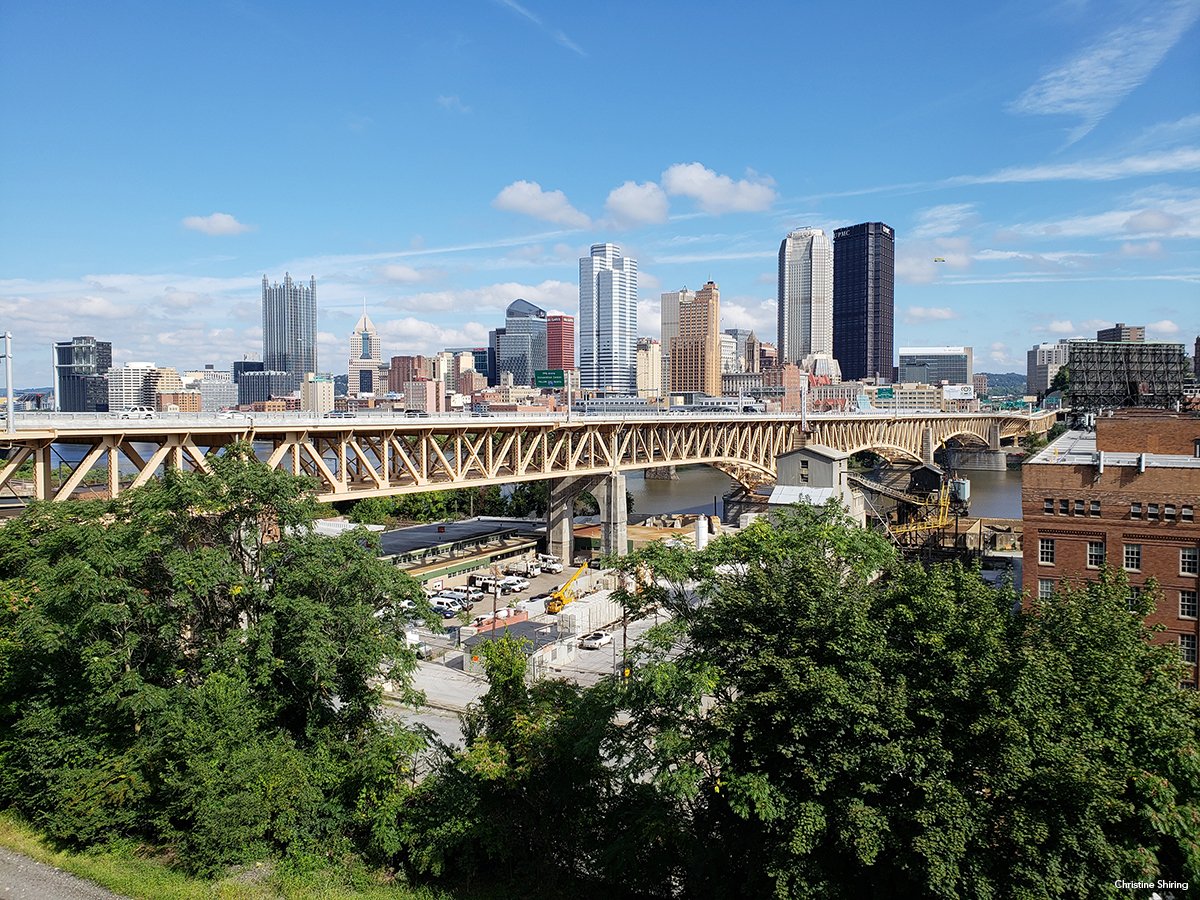
Liberty Bridge
The Liberty Bridge, completed in 1928, crosses the Monongahela River and links Downtown with the South Hills through the Liberty Tunnels. It’s a crucial commuter route, and though it faced a major crisis in 2016 due to a construction fire that warped part of the bridge, emergency crews were able to repair it quickly. Today, it continues to serve thousands of Pittsburghers daily.
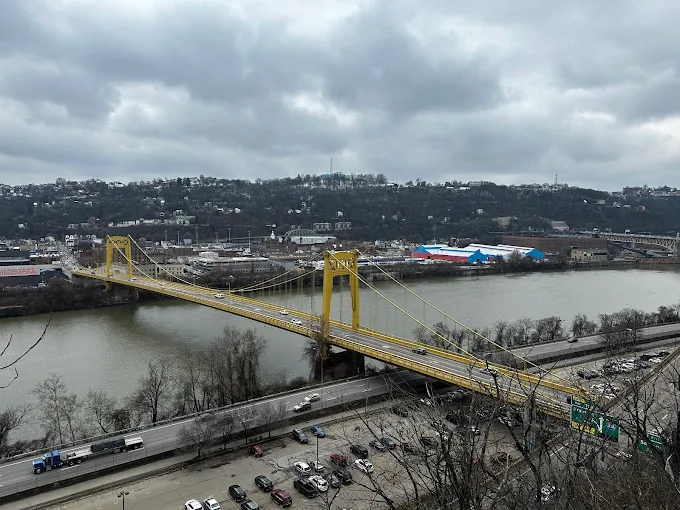
10th Street Bridge (Philip Murry Bridge)
Spanning the Monongahela River, the 10th Street Bridge, officially known as the Philip Murray Bridge, connects Downtown Pittsburgh to the South Side, just a stone’s throw from the lively SouthSide Works and East Carson Street. Built in 1933, this steel cantilever bridge is painted a bold blue and remains a vital commuter link for thousands of vehicles each day.
The bridge was renamed in honor of Philip Murray, a Scottish-born Pittsburgher who became one of the most powerful labor leaders in American history. As the first president of both the United Steelworkers of America and the Congress of Industrial Organizations (CIO), Murray played a key role in shaping 20th-century labor rights and union protections — especially for the steelworkers who helped build Pittsburgh.
While it may not be as instantly iconic as the yellow-painted downtown bridges, the 10th Street (Philip Murray) Bridge is rich in meaning — standing as a tribute to the city’s blue-collar roots and its contributions to America’s industrial and labor history.
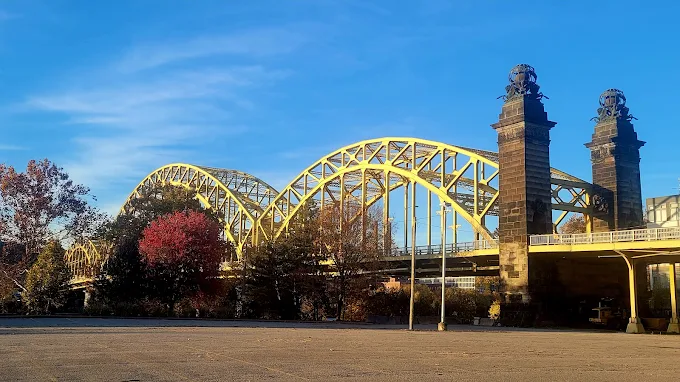
16th Street Bridge (David McCullough Bridge)
Crossing the Allegheny River since 1923, the 16th Street Bridge was renamed in 2001 to honor Pittsburgh native and Pulitzer Prize-winning historian David McCullough. With its graceful steel arches and ornate detailing, it connects the Strip District with the North Side, making it a popular crossing for those exploring food markets and history all in one afternoon.
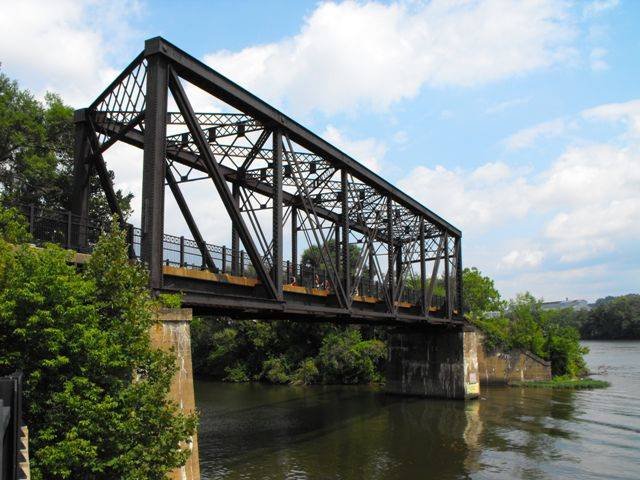
30th Street -Washington Landing Bridge
Once known as the Herr’s Island Railroad Bridge, the 30th Street Bridge now serves as a pedestrian and bicycle bridge crossing the Allegheny River, connecting the Three Rivers Heritage Trail to Washington’s Landing — a revitalized island oasis just minutes from Downtown Pittsburgh.
The bridge originally carried railcars to Herr’s Island, which was once home to stockyards and meatpacking plants. As the island underwent major environmental cleanup and redevelopment in the late 20th century, the bridge was repurposed for recreational use. Today, it provides scenic access to the island’s marinas, rowing clubs, walking paths, and residential areas.
Washington’s Landing gets its name from a fascinating piece of local history: in 1753, a young George Washington is believed to have spent the night there after his raft capsized while crossing the Allegheny River during a mission that helped spark the French and Indian War. Crossing the 30th Street Bridge today is like stepping into both nature and history — a quiet and beautiful break from the city hustle, just a short bike ride away.

40th Street -Washington Crossing Bridge
The 40th Street Bridge, officially named the Washington Crossing Bridge, spans the Allegheny River and connects the Lawrenceville neighborhood to Millvale. It was completed in 1924 and named to commemorate the point nearby where George Washington is believed to have crossed the Allegheny River during his 1753 expedition — a mission that played a key role in the events leading up to the French and Indian War.
This open-spandrel arch bridge features beautiful stone piers and detailed ironwork that reflects the elegance of early 20th-century bridge design. It’s shorter than some of Pittsburgh’s more massive river crossings, but it’s rich in character and steeped in history.
Today, the Washington Crossing Bridge carries Route 2124 and is a vital connector for commuters heading between the East End and North Hills. If you’re driving across it, take a moment to appreciate that you’re following in the footsteps — or paddle strokes — of one of America’s founding figures.
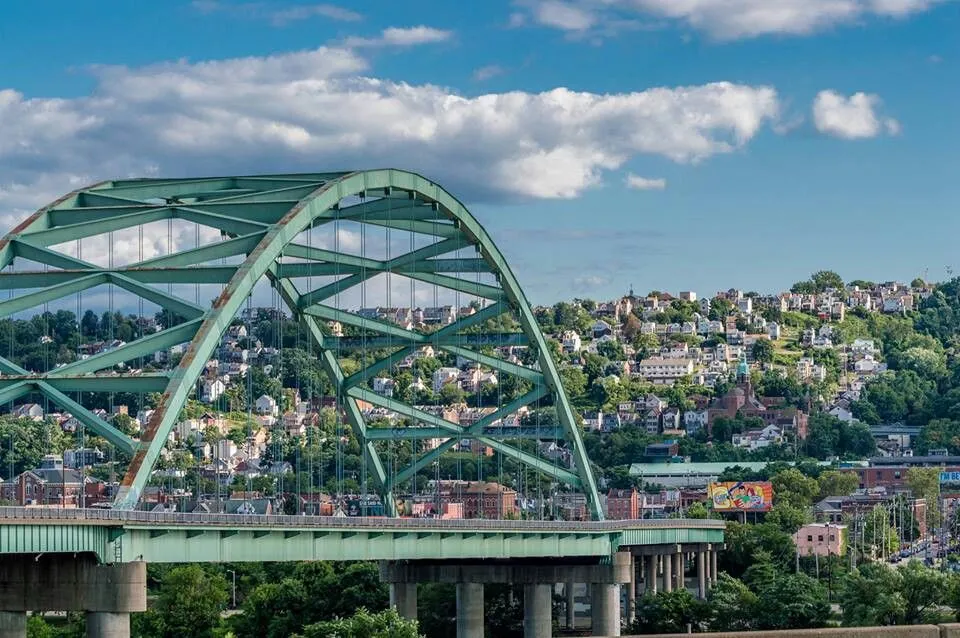
Birmingham Bridge
The Birmingham Bridge, built in 1977, spans the Monongahela River and connects the South Side to the Bluff neighborhood and Uptown. This steel tied-arch bridge was named after the city of Birmingham, which merged into Pittsburgh in the 19th century. It’s often used by university students heading to Duquesne or commuters navigating the southern neighborhoods.
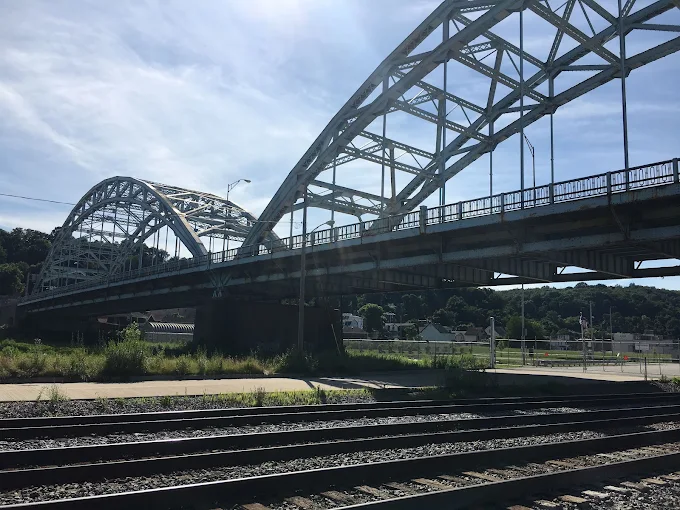
McKees Rocks Bridge
The McKees Rocks Bridge, which spans the Ohio River, opened in 1931 and remains one of the longest bridges in the Pittsburgh region, stretching a total of 7,293 feet (nearly 1.4 miles). This massive cantilever bridge connects the industrial community of McKees Rocks to Pittsburgh’s western neighborhoods and is a vital artery for both commuter and freight traffic.
With its gritty, industrial vibe and panoramic views of river traffic, train yards, and steel mills, the McKees Rocks Bridge feels like a time capsule from Pittsburgh’s working-class heyday. It’s not flashy, but it’s tough, dependable, and unmistakably Pittsburgh.
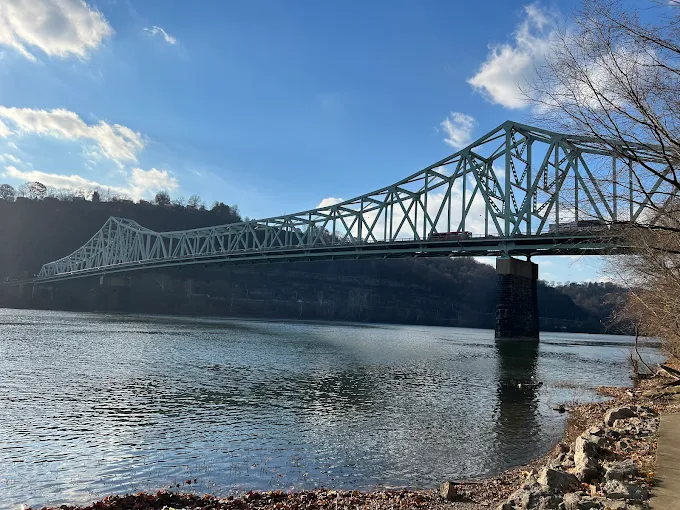
Sewickley Bridge
Crossing the Ohio River, the Sewickley Bridge connects the town of Sewickley with Moon Township and surrounding areas. The original bridge was completed in 1911, but by the late 20th century, it had become structurally outdated. In 1981, a brand-new bridge was built in the same location using a modern cantilever design — and interestingly, it reused the original stone piers from the 1911 version.
Today’s Sewickley Bridge is a striking green steel structure that carries Route 4025 and remains a vital link for commuters and residents. It’s also one of the few remaining toll-free bridges over the Ohio River in this region, and it’s particularly scenic at sunset.
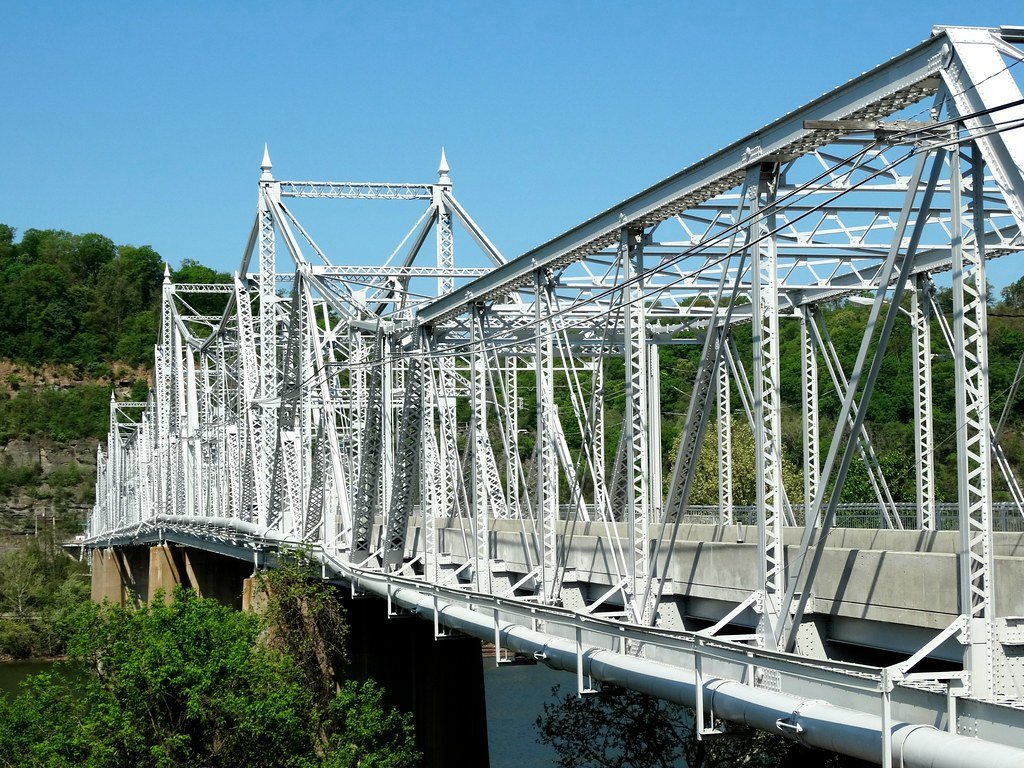
Ambridge–Aliquippa Bridge
Crossing the Ohio River, the Ambridge–Aliquippa Bridge — often just called the Ambridge Bridge — opened in 1927 and links the towns of Ambridge and Aliquippa. It’s a classic cantilever through truss bridge, designed during a time when both towns were industrial powerhouses in the steel and manufacturing world.
What makes this bridge even more significant is its deep connection to the American Bridge Company, the very reason Ambridge exists. Founded in 1903, the American Bridge Company was a major fabricator of steel for iconic projects across the U.S., including parts of the Empire State Building, the Chrysler Building, and numerous bridges around the country. The town of Ambridge—short for American Bridge—was built as a company town to support the booming operations there.
For those of us who grew up in Ambridge, this bridge isn’t just a crossing — it’s part of our hometown identity. From the clang of steel to the hum of traffic, it echoes the legacy of hard work, craftsmanship, and community that built the region. Even today, driving across the bridge feels like coming home.
Only Scratching the Surface
While we’ve only highlighted a handful of Pittsburgh’s most iconic bridges, they represent just a small piece of the puzzle — there are 446 bridges in and around the city, each with its own story, purpose, and character. From hidden neighborhood crossings to massive steel giants, every bridge plays a role in shaping the landscape and identity of Pittsburgh. There’s so much more to discover, and I can’t wait to explore even more of them with you.
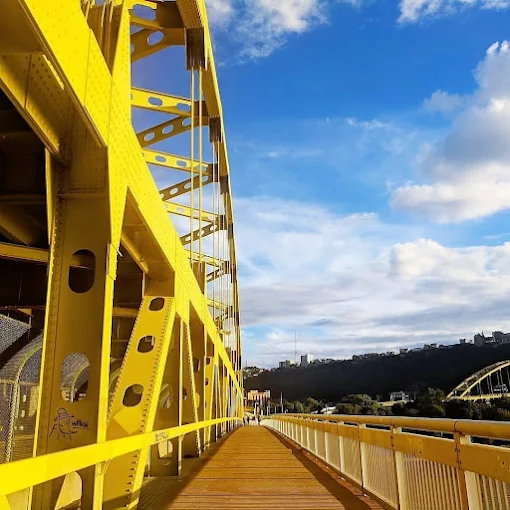
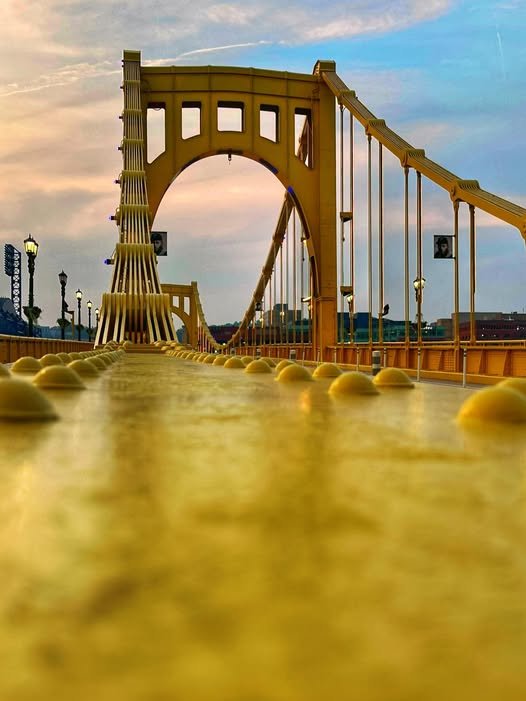
See ya on the road
Susan
My Final Thoughts
As someone who has lived in Pittsburgh my entire life, I’ve come to realize just how deeply connected this city is — literally and emotionally — by its bridges. Each one tells a story. Some reflect the glory of the steel industry, others symbolize rebirth and reinvention, and a few are just plain beautiful to walk across.
Whether I’m driving through the Fort Pitt Tunnel and catching that million-dollar skyline view, or strolling across the Three Sisters on a sunny afternoon, I never stop appreciating the bridges that make Pittsburgh so special. They’re not just steel and concrete — they’re part of our daily lives, our skyline, and our soul.
If you’re ever in Pittsburgh, don’t just drive over the bridges — walk them, bike them, photograph them, and feel the heartbeat of this incredible city. Trust me, you’ll never see bridges the same way again.

